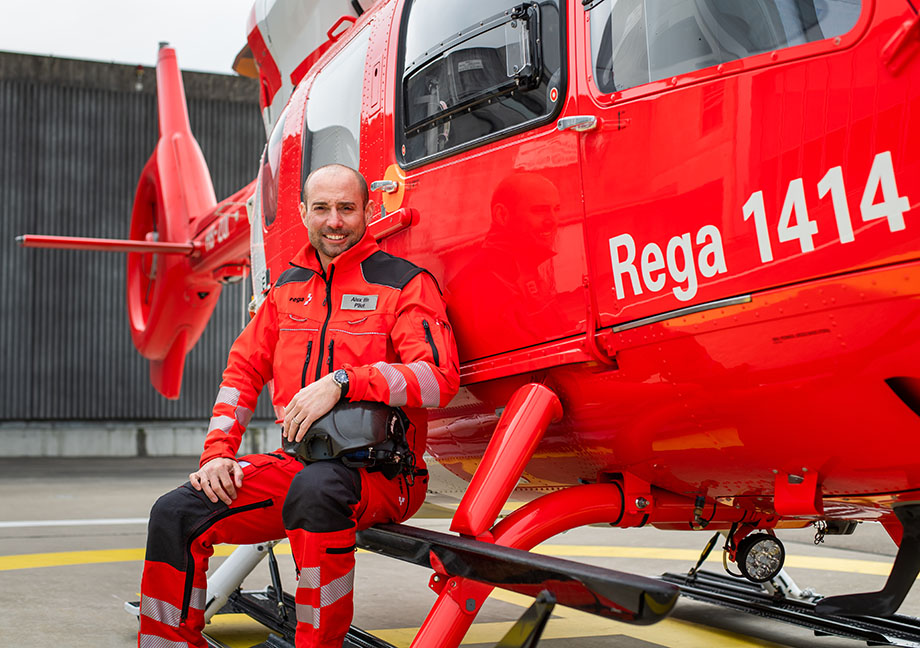Questions for the helicopter pilot
Do you want to fly helicopters when you grow up? Do you want to know what it takes to be a pilot? Or are you simply interested in helicopters?
Do you want to fly helicopters when you grow up? Do you want to know what it takes to be a pilot? Or are you simply interested in helicopters?

Rega helicopter pilots have answered exactly these questions and many more below.
Do you have a question, too? Then send it to us now using the form below.
Tim (8) Bern (BE)
Yes, in the helicopter we have a navigation system, as well as many other devices that help us find our way during the day and at night. In addition, we pilots also know our operational areas very well, so we can also orientate ourselves by the mountains, lakes, villages and rivers.
Leyana (6) Altdorf (UR)
We have a total of 20 rescue helicopters and 14 operational bases. Because our bases are spread all over Switzerland, we can reach any location within 15 minutes’ flying time. The Rega base closest to you is in Erstfeld (UR). We need more helicopters than bases because our helicopter mechanics regularly check the machines – and while they’re doing this, the helicopters can’t fly missions.
Flavio (5) Paspels (GR)
I fly a Airbus Helicopters H145 helicopter. It can fly at 230 km/h. The cheetah, the fastest animal on land, can reach speeds of up to 120 km/h. This means that Rega’s helicopters are always at the incident site very quickly when they’re needed.
Noam (5) Tramelan (BE)
No, we’re allowed to get out of the helicopter and wait at the base. But as soon as our Operations Center calls us out on a mission, we head for the helicopter straight away. It’s only two or three minutes before we’re in the air. Sometimes the alarm sounds during lunch, in which case we leave the food on the table and take off in the helicopter immediately.
Tiziano (11) Monthey (VS)
No. I feel very safe in the helicopter. All of the crew members are very highly trained. We regularly take part in training sessions, and have a lot of experience as well as modern, well-maintained rescue helicopters. We trust each other completely and can fully rely on each other.
Lowenna (10) Bennwil (BL)
Yes, every year our Operations Center organises around 1,200 transports of cows or other farm animals that are sick, injured or sometimes unfortunately already dead. These flights are carried out by commercial helicopter firms on behalf of Rega. This allows our rescue helicopters to always be available to help people in distress.
Mika (4) Saignelégier (JU)
When we’re in the air, someone urgently needs our help – for example, because they’re seriously ill or have had an accident. So we have to fly to that person as quickly as possible and help them. That’s why unfortunately we haven’t got time to land in your garden and visit you. But you’re welcome to wave to us when you see us fly past!
Josselin (7) Bottens (VD)
That’s the tail rotor. Without it, the helicopter would turn round and round on itself as soon as the main rotor – which is the big one on top of the helicopter – really gets going. We couldn’t fly like that, we’d all feel sick. Thanks to the tail rotor, this doesn’t happen and I can turn the helicopter slowly and in a controlled manner around its own axis. I control the power of the tail rotor with my foot pedals: if I press the pedal down with my right foot, for example, the helicopter turns to the right, and with my left foot it turns to the left.
Lynn (9) und Nino (7) Rafz (ZH)
Yes, we regularly wash the Rega rescue helicopter inside and out so that it is always nice and clean and I have a good view out of the window. We clean the outside more thoroughly together as a crew at least once a week. The inside is cleaned after each mission and depending on how dirty it is.
Emilia (5) und Valentina (3) Jonschwil (SG)
Then we use the rescue hoist. This is a cable hoist with a motor, which is attached above the door on the side of the Rega helicopter. The emergency doctor is attached to the end of the cable and then lowered to the patient on the ground. In this way we can rescue injured mountain climbers, for example. In this film, we show you how such a rescue is carried out and what the tasks of each crew member are.
Leo (8) Courtemaîche (JU)
When you become a helicopter pilot, you have to learn a lot and practise flying with a flight instructor. During these many flying lessons, you get to know what all the buttons, switches and levers are for. It’s rather like driving a car: after a while and with some practice, you know where the indicator is, how to lower the windows, or how to operate the satnav.
Alessandra (11) Landquart (GR)
With the helicopter, it only takes a few minutes. When the alarm goes off, we immediately stop what we’re doing – even if we’re having breakfast. We’re usually in the air within 2 or 3 minutes. On missions with the Rega ambulance jets, things are a little different: the patients abroad are already in hospital and the Operations Center plans the return transport home. So they usually have a little more time. If it’s really urgent, the ambulance jet crews can be in the air within two hours.
As a RegaCLUB member, you have the opportunity to ask the helicopter pilots any questions you might have. Send us your question using the form below. We answer a few questions every month. With a little luck, your question will be chosen and answered here.